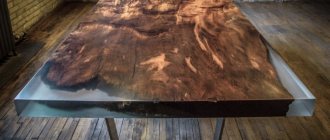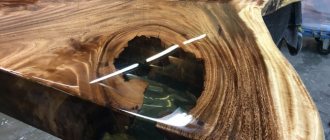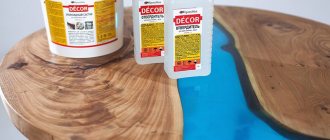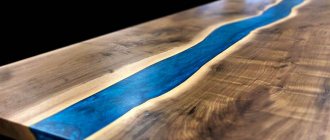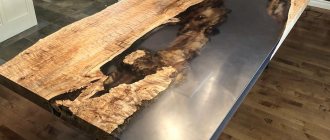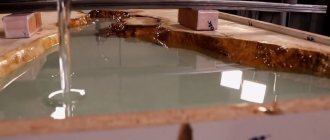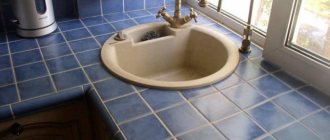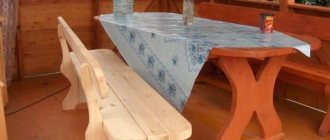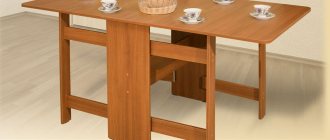Do you want to decorate your interior with unusual furniture, but don’t yet have the skills for complex products? Then you should pay attention to tables made of epoxy resin. The result of the work in most cases exceeds all expectations.
This tabletop is quite wear-resistant. The coating is hard, not afraid of mechanical damage, and protects moisture-sensitive materials well from corrosion and rotting. The hardened resin can easily be washed with water, even with household chemicals.
Good in any interior
Epoxy resins are oligomers that, when mixed with hardeners, form cross-linked polymers. The material is resistant to halogens, some acids, and alkalis. It is used to prepare glue, plastics, varnishes, plastic cements and other materials. Recently, epoxy has been increasingly used in craft furniture production.
There are few disadvantages to using an epoxy countertop. For example, there is no need to subject the hardened resin to prolonged heating to avoid melting. Another drawback is the presence of toxic substances in the composition. Therefore, some craftsmen advise opening homemade furniture with varnish in order to bind toxic substances and prevent them from getting into the air.
Their epoxy resin tables come in several types:
- with a board (plywood) base - resin is used as a decorative layer and to protect the wood;
- entirely made of epoxy resin - such countertops can withstand minimal loads (for example, coffee tables);
- combined - resin inserts are combined with wood, metal, and other materials.
Furniture pieces with a partially or completely resin tabletop look especially impressive. Translucent material transmits light well. Therefore, LED lamps or strips are often built inside to create an additional light source. It will not replace a chandelier, but as a night light or decorative lighting it justifies itself and looks very impressive, especially in the evening.
The resin is used both in its pure form and with various fillers - shimmer, color, phosphor. Thanks to additional components, you can create the most unusual effects - a starry sky, a flowing stream, a stone or mineral surface.
In addition, a wide variety of decor is used. These could be coins, photographs, or just beautiful images. Dry plants and insects are placed inside: the resin acts as a good preservative: the organic matter underneath does not deteriorate and retains its color for a long time.
Epoxy table goes with most popular styles. Furniture combined with wood will easily fit into country, loft, modern, fusion, boho, bauhas, grunge, kitsch, minimalism. Models with metal look organically in industrial, rustic, steampunk, futurism, techno, etc. spaces.
Creative decor ideas
A popular option is a river with filling. Most often, the base is wooden slabs. A solution is poured between them, forming a river between the two banks. The maximum effect is achieved by adding blue dye to the solution.
The slabs can be replaced with saw cuts with unevenness, knots, and cracks. The disadvantages of wood after pouring turn into advantages. Products with a marine theme are also created. The filling is seaweed, pebbles, and shells. Even more original decor is made from photos or other color images. The pictures are glued, filling starts from the center.
The most spectacular luminous models, during the production of which a phosphor is added to the solution (in a ratio of 1x3). In the dark, the areas between the decorative elements create a magical effect.
Resin for countertops: how to choose?
There are certain requirements for resin for furniture:
- good fluidity and low viscosity for an even coating and good adhesion to other materials (thicker compositions are recommended for jewelry);
- high transparency.
For countertops you can purchase the following products:
"Art-Eco"
Resin is also used for layering. The composition already includes a coloring pigment, the color palette is quite wide. The disadvantage of the product is possible yellowing during use.
EpoxyMaster
Epoxy is suitable for forming a layer up to 5 cm. The product has good fluidity and forms a smooth, even surface.
QTP-1130
The composition is designed for layer-by-layer pouring, which is ideal for a beginner. The maximum thickness of the product should not exceed 3 cm.
CHS Epoxy 520
It is used for making decor on wooden or metal tabletops, as well as for restoring wooden furniture.
Often craftsmen try to save on materials by buying budget brands of epoxy. But the savings are not justified. As a rule, cheap compounds turn yellow after drying, and the surface is not always perfectly smooth.
Industrial uses of epoxy
The permanent emergence of new chemical compositions significantly expands the scope of use of epoxy. With its help, it has now become possible not only to glue large objects together, but also to make replacements for metal parts in different designs from it, which will significantly reduce both the cost and weight of the product.
The main areas of application include:
- Manufacturing of composite objects. Fiberglass and carbon fiber are made in a similar way by impregnating synthetic fabric with resin. Afterwards, these materials can be actively used in object-oriented modeling, when creating cars, airplanes, ships, and missiles.
- Furniture manufacture. These can be both ordinary options (for example, kitchen countertops), and real exclusive household decor (slab tables and countertops, artificial rivers and waterfalls, etc.)
- Production of waterproofing/electrical insulating materials. The resin acts as a dielectric and is also waterproof.
- Making jewelry and jewelry work. Resin jewelry looks great and is inexpensive.
- Repair and installation work. Using resin, you can treat a cracked tabletop, renew a floor, repair a small boat (a leak in a wooden fishing boat), patch up a car body, etc.
Working with resin is many times easier than working with ceramics/metal.
How to calculate the amount of material
Before starting work, you need to calculate the amount of material. To do this, use the volume calculation formula. Prepare a drawing of the tabletop, determine the length and width. If you plan to make a tabletop in which the resin will form a sector over the entire height of the product, multiply the resulting area by the thickness of the boards, but if only the top layer will be formed, then multiply by its thickness.
Expert opinion
Korzhavin Daniil Dmitrievich
Designer of stylish home furniture
Resins harden when mixed with a hardener, which tends to expand. Therefore, the solution ready for pouring increases in volume by 10–50%. This must be taken into account when calculating the material. The expansion coefficient is indicated in the instructions for the drug.
- Calculation example. There are two boards 10 mm thick and 1000 mm long. According to the master’s idea, between them there will be a transparent sector made of epoxy resin 300 mm wide. To find out how much resin is needed for pouring, multiply 10x1000x300 mm, resulting in 300,000 mm3, or 300 cm3. This volume corresponds to 3 liters of epoxy resin diluted with hardener.
Preparing for work
The final result depends on the quality of the preparatory work. The surface with which the resin will come into contact is cleaned, washed, degreased, and dried.
Further actions:
- The resin is heated to 50 °C (unless otherwise specified in the instructions).
- Epoxy is poured into a clean, dry container that can then be thrown away.
- Decorative fillers are added - pigment, aerosil, microsphere, wood dust, plasticizer or other materials (as necessary).
- Pour in the hardener in a thin stream, constantly stirring the resin. If you add a component quickly, the base may boil and immediately harden.
- Stir the mixture thoroughly for 2–4 minutes.
It is necessary to strictly observe the proportions of the components. If there is an excess of hardener, the resin thickens too quickly, and if there is not enough, it does not set. Then sticky areas form, causing the quality of the finished product to deteriorate.
When exposed to ultraviolet light, the resin may turn yellow when dry. To prevent this from happening, a UV filter is additionally added to the mixture.
1-Surface preparation; 2-Pouring resin into a container; 3-Adding fillers; 4-Creating frames
A frame for filling is pre-made from scraps of boards and slats. The joints of the box are sealed with sealant to prevent liquid from spilling out. The interior space is carefully lined with film.
Expert opinion
Korzhavin Daniil Dmitrievich
Designer of stylish home furniture
Countertops made of epoxy resin are quite heavy - 35 kg/m2 or more. Therefore, the base and legs should be quite strong.
Instructions for making a table top
Inside the frame, the elements that will form the tabletop are laid out on the film - wood, chipboard, plywood, metal. If you plan to coat them with epoxy resin, then they should be lower than the sides of the formwork.
Next, the resin is poured, starting from the center. The composition spreads over the form under its own weight. If necessary, carefully level the surface with a clean, dry spatula.
1-Pouring the epoxy resin 2-Drying the resin 3-Sanding the product 4-Final finishing
Leave the first layer until completely dry. This may take up to several days. The top of the mold is covered with film to prevent dust or other debris from entering. When the layer has completely hardened, repeat pouring and drying until the desired thickness is formed.
Complete polymerization of epoxy resin occurs in approximately 24 hours. This depends on the thickness of the layer and the properties of the hardener. Therefore, gradual filling takes a lot of time.
Next, they move on to sanding to get rid of irregularities. Although some manufacturers produce products that do not need to be processed after hardening (this should be indicated in the manufacturer's instructions).
Coarse sandpaper
Fine sandpaper
Grind the hardened resin with waterproof sandpaper with a coarse grain, and finally with the finest dusting. Recommended skin numbers are from 80 to 2000. The stove is watered all the time. Then finishing is carried out with abrasive pastes.
The next stage is finishing. Standard coatings are applied to wood - protective impregnations, waxes, varnishes. The part of the tabletop formed with epoxy resin must be covered with film or mounting tape.
Features of working with resin
- When working with epoxy resin, you must strictly adhere to the proportions of components specified by the manufacturer.
- The room should be dry. Do not allow moisture to get into the resin so as not to spoil the product. The optimal temperature for work is +22 °C. When the temperature drops sharply, white flakes appear in the pour. Therefore, temperature changes must be avoided until the resin is completely dry. Do not work with the material at low temperatures, as the resin may delaminate.
- The colder the room, the thicker and more difficult the material to work with. The higher the room temperature, the faster the resin hardens.
Expert opinion
Korzhavin Daniil Dmitrievich
Designer of stylish home furniture
Do not speed up the drying process. If you heat the surface from above, the tabletop may become deformed.
- Mix the hardener with the resin slowly and carefully. Active stirring can lead to the formation of air bubbles in the mixture, which are difficult to get rid of.
- The components must be connected carefully. If the mass is not uniform, then poorly hardened areas and sticky spots will form on the countertop. To prevent this from happening, craftsmen recommend pouring the resin from one container to another several times. In this case, you need to mix the mass in the thickness, trying not to lift the tool to the surface.
- If bubbles do appear, you can get rid of them. While the resin has not hardened, the problem area is heated with a construction hairdryer.
- Cloudiness can also be eliminated. Thus, masters claim that the mass becomes transparent again, as soon as it is heated to a temperature of 60 °C.
- Experts recommend mixing no more than 1–5 kg of resin at a time (depending on the size of the table). A large volume of working solution can harden directly in the bucket in a matter of minutes. It is recommended to use only modern hardeners such as Etal-45M.
Another danger of unused epoxy resin is the possibility of it catching fire when stored in a thick layer. For this reason, it is recommended to pour the resin in thin layers. This technology has its advantage: you can create a stereo effect if you additionally decorate each layer.
Types and chemical compositions of resin used for casting
Epoxy has been used by people in everyday life for a long time. For any household work that requires a reliable and solid connection, it has become an indispensable assistant.
Based on their composition, several types of resin are distinguished:
- Epoxy-Dian, which are marked with the letters “ED” and have numbers 10,16,20 and 22. EP-SM-PRO resin also belongs to this series. These substances are widely used in both household and industrial areas: the production of complex materials (compounds) with the possibility of impregnation, the installation of self-leveling floors, the production of adhesive compositions, etc. This is not the entire list of applications of this type of resin;
- Epoxy diane used in the production of varnishes and paints. They are marked “E” with numbers 40 and 40-R. Indispensable in the creation of paint and varnish coatings;
- Epoxy-modified – marked “EPOPHOM” with numbers 1,2,3. Used for repair work;
- Special purpose epoxy. They may contain other substances, for example, resorcinol, chlorine, so their use is possible under special environmental conditions.
It is worth noting that any epoxy includes two elements - a hardener and the resin itself. And different fillers give it special properties.
Epoxy and its consumer qualities
The cost of this substance is quite high. Purchasing a small quantity for household needs will not particularly hurt your pocket, but purchasing large quantities will require considerable cash outlay. However, the popularity of resin among the population does not decrease. This fact can be explained by the excellent qualities of the polymer, which include the following:
- Bond strength. In some cases, with a high degree of compliance with the process technology, the hardened mixture may well provide worthy competition even to individual types of concrete;
- Heat resistance. The resin can successfully withstand high temperatures (+200 degrees Celsius and even higher);
- Moisture resistance. When hardened, the resin does not allow or absorb moisture at all;
- Adhesive properties. High level of adhesion, subsequent bonding strength, capable of gluing large surface areas;
- Practical resistance to most aggressive substances (for example, acids);
- Light weight when frozen.
The listed properties are typical for all types of these substances. Properties can be reduced or increased by adding special components to the resin used in its production. When purchasing epoxy resin, you must make sure of the intended purpose of the composition. This information can be obtained from the information written on the label or by consulting with a sales consultant. Even a slight deviation from the composition required for certain jobs can directly distort their results.
Areas of use of epoxy
The scope of its application is quite wide. The substance is very popular in use for both domestic and industrial needs. In turn, the technologies used for the manufacture of epoxy are being improved on an ongoing basis, which expands the scope of its application. At the same time, the composition acquires updated qualities.
Most often, resin is used in production to solve the following problems:
- Bonding surfaces and impregnating fiberglass. This is necessary for the construction industry, electrical engineering and radio electronics, aircraft and mechanical engineering, in the production of fiberglass, in the repair of cars and ships;
- Formation of a waterproofing layer. A similar symbiosis of epoxy with other materials is used to cover walls in rooms with high humidity, basements, swimming pools, and other containers in which liquids are stored;
- Creation of chemically resistant coatings for their interaction with internal/external environments, as well as protection of porous materials;
- Creating transparent parts and objects by pouring resin into molds. In the future, such parts can be subjected to cutting, grinding, and other mechanical processing.
If you need to glue hard surfaces, epoxy glue is much better suited than any other epoxy resin composition. Of course, the adhesion effect can be achieved, but a special composition (glue) will allow you to achieve much better results.
Safety rules when working with resin
When working with epoxy resin, adhere to the following safety rules:
- Use personal protective equipment - gloves, respirator, goggles. If the mixture gets on the skin, eyes or mucous membranes, chemical burns are possible. Prolonged inhalation of vapors can cause poisoning.
- Small children or animals should not be allowed into the workroom.
Do you like the look of epoxy resin tables?
Very! Not really
- Tools and dishes are cleaned with acetone - the liquid dissolves the product well, or thrown away.
- It is prohibited to carry out work near an open source of fire.
Even a beginner can handle making a table from epoxy resin. But there is a condition: you need to follow all the instructions of the material manufacturer and listen to the recommendations of the craftsmen. Otherwise the material will be damaged. And if safety rules are not followed, you can also harm your health.
DIY epoxy resin kitchen countertop: reviews
Reviews note the beauty and originality of epoxy countertops. The situation gets worse when making to order. Not all craftsmen are conscientious, so the tables crack and turn yellow.
The cost of such products is low; costs are required at the stage of purchasing materials. However, when making it yourself, the result is not always positive. Correcting errors requires additional costs. Therefore, this work should be carried out responsibly, follow the recommendations of the epoxy manufacturer, and follow the technology.
